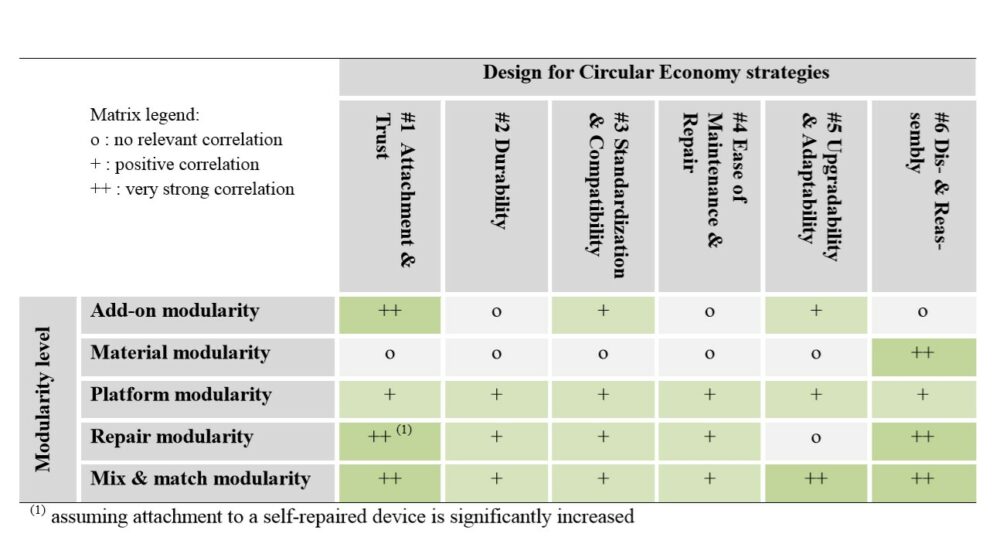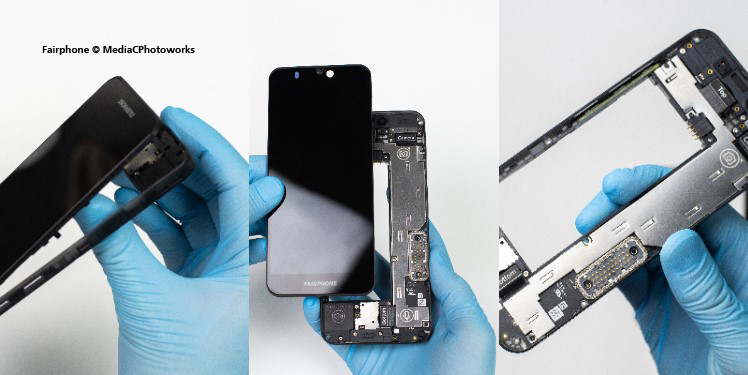Making smartphones modular might become the crucial choice for manufacturers as users have come to expect longer-lasting and more sustainable products. The discussion about modular smartphones has gained renewed vigor as thinking about the environmental impact of smartphones is changing and environmental criteria like their longevity, durability, upgradeability, and repairability are gaining more traction. What modularity means and how it actually influences the sustainability of a product is explained in our new blogpost.
The Many Meanings of Modularity
The modules making up a modular product are by definition structurally independent elements. This could be a mono-material back cover or sub-assemblies with defined interfaces, like a removable battery. The next stage in the evolution of modular design might be a platform that allows manufacturers to deliver truly customized units.
Modularity can be divided into a kind of environmental hierarchy. The level of add-on modularity is mostly a mere convenience aspect, as it enables users to attach a range of add-on peripheral functions to a given core (display-CPU unit). Conventional environmental design strategies do not apply here, as the life expectancy of the core parts does not change by adding or removing add-on modules.
Material modularity allows users to easily separate some materials, such as covers and batteries. The Fairphone 1 and several other conventional smartphones have achieved this type of material modularity and are designed with recycling in mind.
A product on the level of platform modularity can be configured for a range of individual specs. Configuring products like the Rephone or the click ARM tablet requires basic technical knowledge and is potentially useful for repair, refurbishment, or reuse.
The Fairphone 2 and 3 as well as the SHIFT 6m are examples designed for repair, refurbishment, and reuse, as the key components can be easily replaced, which makes these products reach the level of repair modularity.
Mix & match modularity includes the repair modularity and involves a shared backbone and/or standardized module interfaces, which bears the risk of a significant rebound effect. It depends on the user whether the ability to replace modules indeed helps keep the device in use, as users might just replace individual modules much more frequently to keep pace with latest technology advances.
Tablets and smartphones are used constantly in the everyday life. Technical performance, software compatibility, and access to up-to-date features are important for the majority of users. Only very few products that are replaced are actually affected by technical failures.
Modularity inevitably means more material consumption. In some cases, the product might need to be larger in order to accommodate all of the configuration options or the addition of expected future technologies. This must be offset through a considerably longer use of individual devices and modules. Modular product design is therefore not necessarily the most sustainable design option in itself if the end products are used only as long as conventional phones. Modular devices may need more material input for the required connectors and module housing, and they might suffer from poorer reliability caused by their easy-to-open cases. Also, water tightness might be more difficult to achieve, and users might be drawn into a state of ‘overprovisioning’ of modules and spare parts.
From a circular economy perspective, modularity should be understood as a potential contributor to resource efficiency as it may enable longer active use. The modular smartphone is a concept with the potential to maintain functionality continuously: parts of the device could be customized or upgraded without having to replace the whole product.

Modularity and the idea of a circular economy
“A circular economy is one that is restorative and regenerative by design, and which aims to keep products, components and materials at their highest utility and value at all times, distinguishing between technical and biological cycles.” (Ellen MacArthur Foundation 2016)
There are six defined product strategies (Bakker et al.) for circular business models, all of which can be implemented in different ways for different products and where the modularity concept could be applied.
- The first strategy ‘attachment and trust’ is based on a bond between user and object. There are many reasons to quit using a product, including the inevitable unintentional changes to the product, such as sudden noises, wear and tear etc. Modularity can make a product unique and personalized, which can inspire stronger bonds of attachment and trust. Affordability and the brand image are also relevant factors for attachment in the smartphone business in particular, as is the idea of the open source: being able to control the software and the operating system, to adapt the functionalities of modules, or create own modules is highly relevant for some users. Trust is influenced by believing in a long life for the product: the mere assumption that a product is of a lower quality and has a shorter life expectancy will put some users off repairing it.
- The technical aspect of defining the optimum product reliability is expressed in the idea of designing for ‘durability’, which should take the commercial and stylistic lifespan of the product into consideration as well. Durability is about imagining what could happen to a product throughout its lifetime, and about establishing mission profiles. This first aspect of durability might be perceived to be an argument against modularity, as additional interfaces are typically weak spots in terms of reliability. Mechanically flexible module connector designs can be more reliable than rigid connection technologies. Hard-fact technical reliability is crucial, but the perception of reliability also plays a role. The option of DIY repairs through modularity contributes to durability. However, repairability will not have a major impact on a smartphone’s life expectancy: Higher performance and new service contracts, often including new phones, are the dominant reasons for users choosing new smartphones, with device defects or aging batteries being less prominent reasons.
- ‘Standardization and compatibility’ means following certain standards in the hardware and software. A good example of resource efficiency through compatibility are USB chargers, which are compatible across several device generations and have longer lifecycles than the smartphones they are often originally sold with. Compatibility is key for platform modularity and mix & match modularity. Several modular phone concepts rely on proprietary standards, such as Google ARA (cancelled), RePhone, and Puzzlephone, but there is no initiative yet to standardize interfaces across different modular phones. A business concept originally pursued by Google and Circular Devices suggested that the specification of the interfaces were to be published, allowing the development of customized compatible modules and enabling third parties to join the ecosystem.
- The complex task of designing for ‘ease of maintenance and repair’ concerns the original manufacturer, service providers, and users and requires solid knowledge of the parts which typically require maintenance and repair. Ease of maintenance and repair means easily exchangeable parts and makes it more likely that products actually reach their optimum lifetime. This design can yield a profit when the business model is built on providing a service, instead of selling a product, and if ownership of the product remains with the supplier. Due to accidental damage, smartphone displays frequently require repair and are prime candidates for modularization, similar to batteries which wear out through constant charging and discharging. The next level of designs enabling modularization would be non-permanent solutions for fitting the glass and display panels.
- ‘Adaptability’ involves the ability to access different functions by replacing parts, whereas ‘upgradability’ is more challenging: It means anticipating future technology developments. Designing for adaptability and upgradability forces us to project scenarios well into the future. Smartphone users want to benefit from increasing performance and, as user expectations grow, the performance of modular smartphones should improve as well. Repairing broken parts and replacing aged (battery) or technically outdated (storage) parts may extend the active use of core components (PCB and ICs), which is beneficial for the bigger picture. On the other hand, if adaptability makes the replacement of modules too easy and too convenient, this could have a negative sustainability effect by increasing the amount of waste and reducing the actual active use of each individual module.
- An additional design perspective comes into the picture when ‘dis- and reassembly’ is concerned, i.e. the non-destructive disassembly and the possibility to put together the whole product from pieces. Easing and speeding up the process of disassembly and reassembly is one of the main assets of modular product design. Although manual disassembly is typically understood to be the intended outcome at the end of a product’s life, disassembly as an aspect of eco-design is envisioned with the recycling process in mind, and reassembly may indeed mean assembling a product with components from other products.
Modular design fits well into the concept of circular economy (Figure 2), even though that material modularity is not a perfect match for a circular economy. Add-on modularity has no obvious correlation with many of the strategies, but platform, repair, and mix & match modularity all correlate with (almost) all design strategies.

Modular electronics for recycling
The Fraunhofer 2013 disassembly study took apart tablet computers and distinguishes between two archetypes: aluminium and plastic housing. The tablets with plastic housing achieve their required stiffness by adding an internal magnesium frame. The roughly 200 million tablets sold worldwide contain about 5,000 tonnes of high-grade printed circuit boards.
Although tablets are challenging to recycle, there are some promising design options among individual brands. A removable battery which is accessible from the backside of the tablet is the best case in terms of modularity.
Taking a look at the inner structure of a tablet shows that most current tablets are already arranged in modules. A similar assembly structure can also be found in many smartphones, where the display, back shell, electronics, and battery are clearly distinct parts of the product, but closely connected through screws, clips, cables, connectors, adhesive etc.
Manufacturing clearly dominates the lifecycle impact of smartphones; even recycling yields only marginal credits. A total carbon footprint of 75 kg CO2-eq. has been calculated for the iPhone SE, of which 82% come from production alone (Apple Inc.) This calculation does not include any stated credit for recycling; it can be assumed that even optimal recycling could only amount to a 10 to 20% reduction on the production’s carbon impact. The most sustainable way to use a smartphone is therefore to keep the product and all of its component in use for a long time.
In the context of the circular economy, prolonging the active life of electronic products is the main parameter for reducing their environmental impact. While recycling – as a ‘radical value reducer’ – only has minimal benefits, modular devices have the potential to enable continuous functionality for longer use. Modular products could also empower users to disrupt the current use and consumption cycles for smartphones. The technical possibilities need to be understood, as do the environmental implications and the interaction with the user. There also needs to be a more conscious handling of the given opportunities. Products have to be seen in the context of their specific business models. There won’t be a ‘one-size-fits-all’ solution that fulfils all different user needs and reduces environmental impacts, but technical design offers various prospects. How they are used depends strongly on the user. Optimum modularity cannot be based exclusively on questions of technical design alone, as it needs to consider how products are used in real life and how design features impact their users’ buying decisions and the time they keep a product in active use.
This article is based on the research publications “Modular Products: Smartphone Design from a Circular Economy Perspective” and “Decreasing obsolescence with modular smartphones? – An interdisciplinary perspective on life cycles” and was composed by Marieke Lienert.
Other sources:
(1) C. Bakker, M. den Hollander, E. van Hinte, Y. Zljstra: Products That Last – Product Design for Circular Business Models, TU Delft Library, 2014
(2) Apple Inc.: iPhone SE – Environmental Report, March 2016
IT CAN BE ALSO INTERESTING FOR YOU:
- We Could Be Treating Diabetes, Asthma, and Parkinson´s Tomorrow
- Is Heterogeneous Integration a Panacea For the Electronics Industry?
- Will Chiplets Revive Moor’s Law?
- How Waterproof Flexible LED Systems Became a Reality



Chi says:
Love this site keep up the hard work!
Marieke Lienert says:
Thank you, we will!